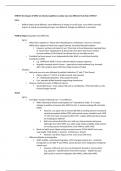HFDYAT the impact of WW2 on American politics & society was very different from that of WW1?
Intro:
- Political impact most different, some difference in impact on social issues, very similar economic
impact overall unconvincing to argue ‘very different’ though was different to an extent
Political Impact (arguably most different):
- Agree
o WW1 led to support for ‘laissez-faire’ Republicanism, isolationism, return to ‘normalcy’,
WW2 led to support for New Deal, support abroad, increased liberalism/welfare
However, perhaps not impact of war? More due to Great Depression exposing flaws
of ‘laissez-faire’ republicanism & Roosevelt’s New Deal. Also Hoover tried to
increase welfare (1930 Federal Farm Board) but was too little too late
o President had more power to act independently after WW2 vs. restrictions faced by
Presidents in WW1
E.g. 1948 Berlin Airlift, Truman ordered without Congress approval
Arguably strongest point in favour – especially as trend continued (e.g. Kennedy
didn’t tell congress about 1961 Bay of Pigs invasion of Cuba)
- Disagree
o Both post-war eras were followed by political radicalism (1 st and 2nd Red Scares)
Palmer raids in 1st (1919) 6,000 arrested, 556 reported
2nd: 1948 Elizabeth Bentley, 1950 Joseph McCarthy
Gov. attention shifted towards suppressing communism
o However, Red Scares were of different natures
Second Red Scare = more radical, FBI curb on civil liberties, 1950 Committee on the
Present Danger formed
Social:
- Agree
o Civil rights reactions following wars = very different
WW1 followed by female emancipation (19th amendment 1920), no major
changes in position of women after WW2 (in fact, ½ women working left work after
WW2)
However, can argue role of women did shift as working women increased &
societal perceptions shifted (78% said married women shouldn’t work 1938
13% 1942, later increased to 38% 1978 – implies WW2 had direct impact
on changing perceptions)
Both eras women fired after war, both eras improvements during war
(although more after WW2, e.g. wider range of jobs available, black women
on nursing courses increased from 1,100 1940 to 2,600 1943)
Black civil rights movt. Began seeing increased success (1950s NAACP won every
case fought, 1948 Shelley v. Kraemer, 1954 Brown v. Board)
However, not direct impact of war, more to do with movt.
o Different attitudes to immigration
WW1 hostility, restricting immigration, 1921 Emergency Quota Act – restricted
immigration to 357,000 post-WW2, society became more integrated, immigrants
valued more
However, both post-war eras saw immigrants treated as ‘enemy aliens’
(e.g. Japanese– 120,000 shut in internment camps) – despite this, gov.
didn’t push to restrict immigration after WW2, unlike after WW1




